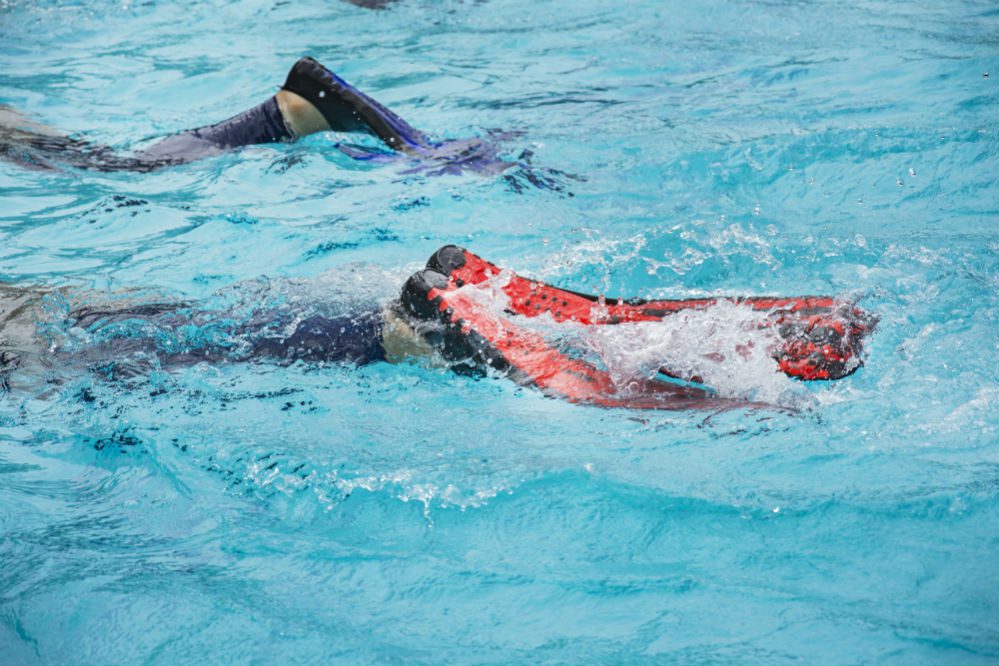
What are fins? How much of an asset are they in your swimming training?
Have you ever come out of the water after a brief swim with your body aching, breath hitching, and pulsating pain in your shoulders? You most likely would decide to ignore it the first time it happens. Then, as the pain only seems to intensify with time, you probably can’t help but wonder why.
Regular swimming involves continuous leg movement which tires your muscles and consequently causes them to become taut overtime. Also, the force that you exert to propel your body forward in the water places immense pressure on your shoulders, making them perpetually fatigued. Vigorous exercises can help ease the pent-up pain, and relax your body muscles, but there is an easier way out—swim fins!
Contents
What Are Fins and Why Should You Use Them?
Fins are rubber-made swimming equipment which will greatly increase forward thrust and help propel your body forward with lesser leg movement. The drastic reduction in energy use will help minimize your oxygen consumption, which significantly improves a swimmer’s technique and performance.
Swim fins will enable you to maintain a higher body-line, steer effortlessly through the water, and give you occasional bursts of acceleration that allow you to reach top speeds much faster. Whether you’re going swimming, bodyboarding, bodysurfing, kneeboarding, riverboarding, or underwater diving, swim fins are just the thing for you.
Specific Benefits of Swimming with Fins:
1. Reduce Shoulder Sprain
Swimming involves repetitive shoulder movements, and so engaging in it for long periods can immensely drain your shoulder muscles. Nothing is worse than a shoulder sprain that lasts for weeks! By providing additional propulsion, swim fins reduce the burden on your torso and shoulders, allowing you to maneuver more freely in the water.
2. Improve the “Up-Kick”
Getting the up-kick right is probably the hardest thing in swim training any person would experience. It requires a lot of technique in bending your body in the appropriate position and hitting the up-kick correctly. A pair of these can increase the surface area of your feet, making it easier for you to thrust your legs upwards in a perfect, narrow, and compact flutter kick.
3. Improve Ankle Flexibility
The rapid, small-range motion of your feet is the key to a perfect kick, and that is no easy feat. Inexperienced and newbie swimmers generally have a horrible kick because they are hardly able to generate any motion with their ankles. The extended surface area and pointed ends of swim fins provide an additional extension to your feet, making it easier to flex your ankles in the water and push forward.
4. Enhance Power and Endurance of the Legs
Swim fins push your body forward with a brilliant surge of force, so your legs are now able to generate more power and reach higher top speed. Along with speed, stamina gets increased, which means more energy for your dives or swims. This increased endurance in your legs will, in turn, strengthen your leg muscles and cause them to produce more powerful propulsion.
5. It’s So Much Fun!
Swimming with fins comes with heck loads of fun. It is more enjoyable to flex your legs in the water and cruise at such incredible speeds.
What Are the Different Types of Swim Fins?
There are a few different types of swim fins and each one has a fairly specific use case. Here are the most common ones:
- Diving fins: These are generally longer than normal swim fins. With their extended fins, they provide greater forward propulsion. Hence, they are more commonly used by scuba divers.
- Long-blade swimming fins: Similar to diving fins, but a little shorter, long-blade swimming fins are used to help generate large propulsion. However, wearing these swim fins frequently can rupture your Achilles tendon. Thus, swimmers are advised to limit their use of long-blade swimming fins to as seldom as possible.
- Short-blade swimming fins: Being shorter in length, short-blade swimming fins provide less propulsion, but reduce the risk of ankle sprains. Hence, they are more commonly used by regular swimmers.
- Finis positive dive fins: These are even shorter than short-blade swimming blades, and are more commonly used for better breaststroke swimming.
How to Choose the Aptest Swim Fin for Yourself?
Choosing the swim fins that are best suited to your needs and desires is a crucial decision if you really want to avoid having blisters and ankle sprains. Swim fins are chosen based on two aspects:
1. Length of the Fins
Different lengths of fins are suited for different types of underwater activities. As mentioned, longer fins are more appropriate for scuba diving, whereas, shorter fins are more appropriate for regular swimming and daily swim training.
Though longer fins will allow you to generate more sprints, they will greatly reduce your kick-frequency. In contrast, shorter fins will refine your stroke technique, but they are absolutely pointless for long-distance swims.
2. Firmness of the Fins
When choosing swim fins, it is imperative to keep the comfort of your feet in mind. Though stiff fins will fit your feet more perfectly and make your legs work more, they have a higher risk of leaving blisters on your skin and causing muscle strain. On the contrary, soft and supple fins will easily bend under the force of water, and will consequently be utterly useless.
Thus, it is best advised to try the fins before buying them and having a good walk around using them. Make sure to pick the ones which are neither too stiff nor too soft.
Conclusion
Now that you know what swim fins are, you can see why they are a significant aid in swimming. They can help improve your swimming techniques considerably. As you can see, there are various shapes and sizes. It’s pretty important that you understand which type is best suited for you and what you are trying to accomplish.
